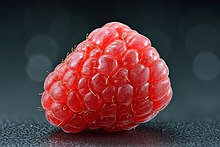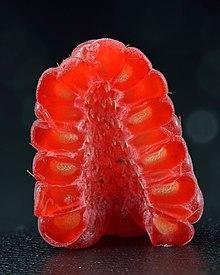Rubus idaeus
| Rubus idaeus | |
|---|---|

| |
| Scientific classification | |
| Kingdom: | Plantae |
| Clade: | Tracheophytes |
| Clade: | Angiosperms |
| Clade: | Eudicots |
| Clade: | Rosids |
| Order: | Rosales |
| Family: | Rosaceae |
| Genus: | Rubus |
| Subgenus: | R.subg.Idaeobatus |
| Species: | R. idaeus
|
| Binomial name | |
| Rubus idaeus L.1753 not Blanco 1837 nor Vell. 1829 nor Pursh 1814 nor Thunb. 1784
| |
| Synonyms[2] | |
|
Synonymy
| |

Rubus idaeus(raspberry,also calledred raspberryor occasionallyEuropean red raspberryto distinguish it from other raspberry species) is a red-fruited species ofRubusnative to Europe and northern Asia and commonly cultivated in othertemperateregions.[3][4]
Taxonomy
[edit]A closely related plant in North America, sometimes regarded as thevarietyRubus idaeusvar.strigosus,is more commonly treated as a distinct species,Rubus strigosus(American red raspberry), as is done here.[5]Red-fruited cultivated raspberries, even in North America, are generallyRubus idaeusor horticultural derivatives of hybrids ofR. idaeusandR. strigosus;these plants are all addressed in the present article.
Description
[edit]Plants ofRubus idaeusare generallyperennials,which bearbiennialstems ( "canes" ) from a perennial root system. In its first year, a new, unbranched stem ( "primocane") grows vigorously to its full height of 1.5–2.5 m (5.0–8.3 feet), bearing largepinnately compoundleaveswith five or seven leaflets, but usually no flowers. In its second year (as a "floricane"), a stem does not grow taller, but produces several side shoots, which bear smaller leaves with three or five leaflets. Theflowersare produced in late spring on shortracemeson the tips of these side shoots, each flower about 1 cm (0.4 inches) diameter with five whitepetals.Thefruitis red, edible, and sweet but tart-flavoured, produced in summer or early autumn; inbotanicalterminology, it is not aberryat all, but anaggregate fruitof numerousdrupeletsaround a central core. In raspberries (various species ofRubussubgenusIdaeobatus), the drupelets separate from the core when picked, leaving a hollow fruit, whereas inblackberriesand most other species ofRubus,the drupelets stay attached to the core. [6][7][8][9]
Biotope
[edit]As a wild plant,R. idaeustypically grows in forests, forming open stands under a tree canopy, and denser stands in clearings. In the south of its range (southern Europe and central Asia), it occurs only at high altitudes in mountains.[8]The species nameidaeusrefers to its occurrence onMount Idanear Troy in northwest Turkey, where the ancient Greeks were most familiar with it.[9]
Cultivation and uses
[edit]

R. idaeusis grown primarily for its fruits, but occasionally for its leaves, roots, or other parts.
Fruits
[edit]The fruit ofR. idaeusis an important food crop, though most modern commercial raspberrycultivarsderive fromhybridsbetweenR. idaeusandR. strigosus.[9]The fruits of wild plants have a sweet taste and are very aromatic.
Leaves and other parts
[edit]Red raspberries contains 31 μg/100 g of folate.[10]Red raspberries have antioxidant effects that play a minor role in the killing of stomach and colon cancer cells.[11][12]
Young roots ofRubus idaeusprevented kidney stone formation in a mouse model ofhyperoxaluria.[13]Tilirosidefrom raspberry is a potenttyrosinaseinhibitor and might be used as a skin-whitening agent and pigmentation medicine.[14]
Raspberry fruit may protect the liver.[15]
Chemistry
[edit]Vitamin Cand phenolics are present in red raspberries. Most notably, the anthocyanins cyanidin-3-sophoroside, cyanidin-3-(2(G)-glucosylrutinoside) andcyanidin-3-glucoside,the two ellagitanninssanguiin H-6andlambertianin Care present together with trace levels of flavonols,ellagic acidandhydroxycinnamate.[16]
Polyphenoliccompounds from raspberry seeds haveantioxidanteffectsin vitro,[17][18]but have no proven antioxidant effect in humans.[19]Raspberry ketonesare derived from various fruits and plants, not raspberries, and are marketed as having weight loss benefits.[20]There is no clinical evidence for this effect in humans.[21]
See also
[edit]- Chambord (liqueur)– raspberry-based liqueur
- List of culinary fruits
References
[edit]- ^"Rubus idaeus".IUCN Red List of Threatened Species.
- ^"Rubus idaeusL. ".Royal Botanic Gardens Edinburgh– viaThe Plant List.Note that this website has been superseded byWorld Flora Online
- ^"Rubus idaeus".Flora Europaea.
- ^"Rubus idaeus".Germplasm Resources Information Network.Agricultural Research Service,United States Department of Agriculture.Retrieved15 December2017.
- ^"Rubus idaeusvar.strigosus".Germplasm Resources Information Network.Agricultural Research Service,United States Department of Agriculture.Retrieved15 December2017.
- ^"Rubus idaeus".Flora of NW Europe.Archived fromthe originalon 6 December 2007.
- ^Lu, Lingdi; Boufford, David E."Rubus idaeus".Flora of China.Vol. 9 – via eFloras.org,Missouri Botanical Garden,St. Louis, MO &Harvard University Herbaria,Cambridge, MA.
- ^abBlamey, M.; Grey-Wilson, C. (1989).Flora of Britain and Northern Europe.ISBN0-340-40170-2..
- ^abcHuxley, A., ed. (1992).New RHS Dictionary of Gardening.Macmillan.ISBN0-333-47494-5..
- ^Martin, H; Comeskey, D; Simpson, RM; Laing, WA; McGhie, TK (2010). "Quantification of folate in fruits and vegetables: a fluorescence-based homogeneous assay".Anal Biochem.402(2): 137–145.doi:10.1016/j.ab.2010.03.032.PMID20361923.
- ^Nutr Res.30(11):777-782
- ^McDougall, GJ; Ross, HA; Ikeji, M; Stewart, D (2008). "Berry extracts exert different antiproliferative effects against cervical and colon cancer cells grown in vitro".J Agric Food Chem.56(9): 3016–3023.doi:10.1021/jf073469n.PMID18412361.
- ^Ghalayini, IF; Al-Ghazo, MA; Harfeil, MN (2011)."Prophylaxis and therapeutic effects of raspberry (Rubus idaeus) on renal stone formation in Balb/c mice ".Int Braz J Urol.37(2): 259–267.doi:10.1590/S1677-55382011000200013.PMID21557843.
- ^Lu, YH; Chen, J; Wei, DZ; Wang, ZT; Tao, XY (2009)."Tyrosinase inhibitory effect and inhibitory mechanism of tiliroside from raspberry".J Enzyme Inhib Med Chem.24(5): 1154–1160.doi:10.1080/14756360802694252.PMID19772488.
- ^Gião, MS; Pestana, D; Faria, A; Guimarães, JT; Pintado, ME; Calhau, C; Azevedo, I; Malcata, FX (2010). "Effects of extracts of selected medicinal plants upon hepatic oxidative stress".J Med Food.13(1): 131–136.doi:10.1089/jmf.2008.0323.PMID20136446.
- ^Mullen, W.; Stewart, A. J.; Lean, M. E.; Gardner, P.; Duthie, G. G.; Crozier, A. (2002). "Effect of freezing and storage on the phenolics, ellagitannins, flavonoids, and antioxidant capacity of red raspberries".Journal of Agricultural and Food Chemistry.50(18): 5197–5201.doi:10.1021/jf020141f.PMID12188629.
- ^Godevac, D; Tesević, V; Vajs, V; Milosavljević, S; Stanković, M (2009). "Antioxidant properties of raspberry seed extracts on micronucleus distribution in peripheral blood lymphocytes".Food Chem Toxicol.47(11): 2853–2859.doi:10.1016/j.fct.2009.09.006.PMID19748543.
- ^Aiyer, HS; Kichambare, S; Gupta, RC (2008). "Prevention of oxidative DNA damage by bioactive berry components".Nutr Cancer.60(Suppl 1): 36–42.doi:10.1080/01635580802398448.PMID19003579.S2CID205494444.
- ^Gross, P (2009)."New Roles for Polyphenols. A 3-Part report on Current Regulations & the State of Science".Nutraceuticals World.Rodman Media.RetrievedApril 11,2013.
- ^"The Sweet Taste of Weight Loss".Ohio State University Food Innovation Center. 2014.Retrieved3 Sep2014.
- ^"Raspberry Ketone".WebMD.
External links
[edit] Data related toRubus idaeusat Wikispecies
Data related toRubus idaeusat Wikispecies Media related toRubus idaeusat Wikimedia Commons
Media related toRubus idaeusat Wikimedia Commons- .Encyclopædia Britannica.Vol. 22 (11th ed.). 1911.
- "Rubus idaeus".Calflora.Berkeley, California: The Calflora Database.
- Rubus idaeusin theCalPhotosphoto database,University of California, Berkeley
- "Rubus idaeus".Plants for a Future.
- "Rubus sachalinensis".Plants for a Future.

